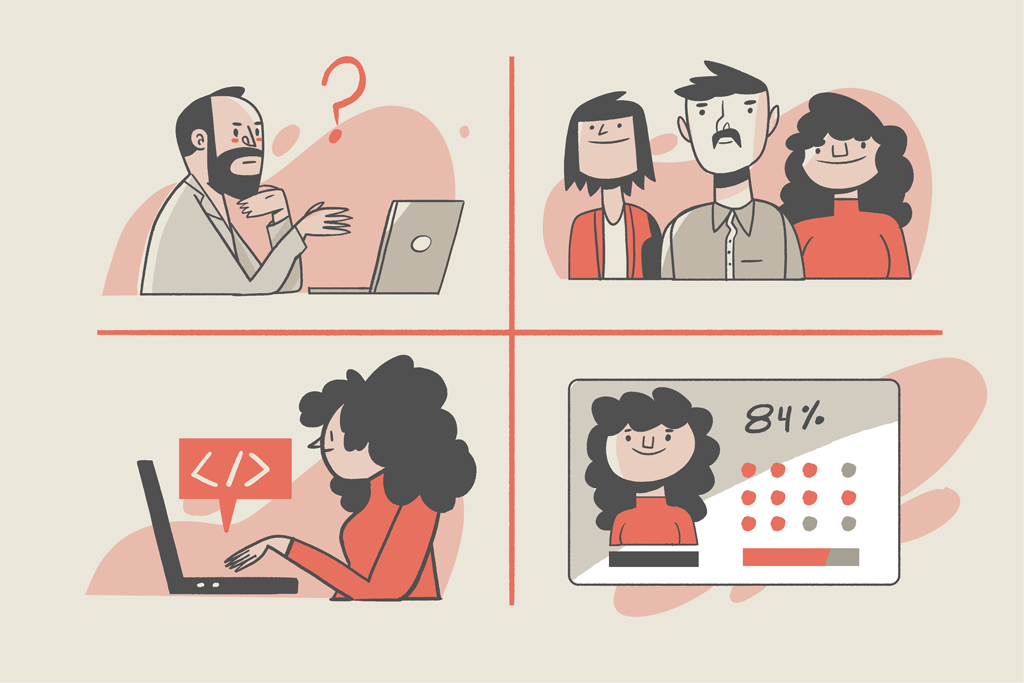What? You Haven’t Yet Standardized Your Tech Hiring Process? Follow These 4 Steps

In our recent webinar on efficiency in tech recruitment, we talked about how a standardized recruitment process can reduce bias, improve quality of hire and elevate candidate experience.
We were thrilled to have Jenny Jongejan on the panel. She’s a Senior Recruiting Consultant with 17 years of Talent Acquisition experience. Jenny has worked extensively with Bay Area startups, enabling efficient, well-documented, standardized hiring processes.
She shared her custom-built, four-step framework for an effective standardized recruitment process. She insists on the importance of becoming crystal clear on:
“I know it sounds prescribed,” Jenny acknowledges, but getting sharp and documenting these 4 elements will lay the foundation for a well-oiled hiring process.
Why you’re hiring: what objective is this role going to impact?
As Jenny Jongejan wisely emphasizes, “Before you even open a role and begin sourcing, it’s so important to know why you’re hiring.” In her words, “What are the business objectives that this role is going to impact?”
Is this a backfill for an existing role, filling a skills gap, or elevating your team with leadership skills? Perhaps it’s a new product requiring niche skills.
Knowing the purpose behind the hire and formalizing an extensive job profile will set the stage for the rest of your process.
Who you’re hiring: what skills and experiences and behavioral attributes do you need?
Once you’re clear on your objectives, it’s time to draft a detailed candidate profile.
This profile should outline the skills, past experiences, and behavioral attributes required for success.
In Jenny’s words, consider, “What technical skills and past experiences are essential for the role? Are there any soft skills or behavioral attributes that would significantly contribute to success in this position?”
How you’ll assess the candidate: for each stage in your interview process, how will you determine if the candidate is a fit?
To evaluate candidates effectively, Jenny recommends implementing a structured interview process.
She emphasizes, “Structured interviews are 81% more accurate in predicting job performance than unstructured ones.”
This entails breaking down the assessment at each stage, from phone screens, to coding tests, to live panel interviews. You should also assign specific interviewers to evaluate particular focus areas.
Jenny suggests, “Assign focus areas to the interviewers who are best equipped to evaluate them.” Also, consider providing interviewers with standardized questions to ensure consistency and reduce bias.
🔖 Related read: Building a Diverse Tech Workforce: A 10-Step Guide to Reducing Hiring Bias
Your evaluation criteria: how will you define what an okay answer looks like versus a great answer?
Lastly, you need to establish clear evaluation criteria. Having a standardized rating scale ensures everyone on your panel is on the same page.
Jenny Jongejan suggests, “Develop a rating scale, such as a one-to-four scale, to evaluate candidate responses […] Define what a one or two answer looks like compared to a good or great one.”
She emphasizes the importance of clearly defining what constitutes each rating level to ensure alignment among panel members.
🔖 Related read: 5 Ways to Strengthen Collaboration Between Talent Acquisition and Engineering Hiring Managers
While implementing this four-step framework may seem like a lot of work upfront, as Jenny points out, “the long-term benefits are undeniable.”
She stresses that it not only ensures that you’re hiring the right people for your organization but also streamlines the process, especially when hiring for multiple positions or high-volume roles, and reduces the bias that a non-standardized process can introduce.